Physical Address
304 North Cardinal St.
Dorchester Center, MA 02124
Meniscal tears are among the most common knee injuries. Abnormal biomechanics after a meniscal injury expose the underlying articular cartilage to increased axial and sheer stress, leading to articular cartilage lesions and early osteoarthritis (OA). The choice of treatment and ultimate prognosis associated with meniscal tears are influenced by such factors as tear orientation, extent, and location. In the United States arthroscopic partial meniscectomy is one of the most commonly performed orthopedic operations, with approximately 1 million patients undergoing surgery each year.
Magnetic resonance imaging (MRI) has been considered the imaging modality of choice in diagnosing meniscal pathology since its first introduction into the clinical practice. MRI accuracy in detecting and characterizing meniscal tears has been extensively reported, with high reported sensitivities and specificities in several studies.
Accurate and prompt diagnosis of meniscal injury is critical to initiate proper treatment and reduce morbidity. Knowledge of the detailed anatomy of the menisci and closely related structures, meniscal pathology, and postoperative changes is critical for an adequate interpretation of knee magnetic resonance (MR) examinations.
The menisci are fibrocartilaginous structures located between the tibial plateau and femoral condyles. Distributing load, delivering congruency, enhancing stability, and contributing to lubrication and nutrition are major functions of normal menisci. Once these functions are impaired, the risk of degenerative changes and morbidity increases.
The shape of the meniscus can be described as an elongated semilunar or C -shape triangle with a concave superior surface and a flat inferior surface. The meniscus is generally divided into thirds: anterior horn, body, and posterior horn ( Figs. 7.1 and 7.2 ). Each meniscus attaches to the flat surface of the tibial plateau via the anterior and posterior root ligaments and accommodates the convex surface of the femoral condyles.
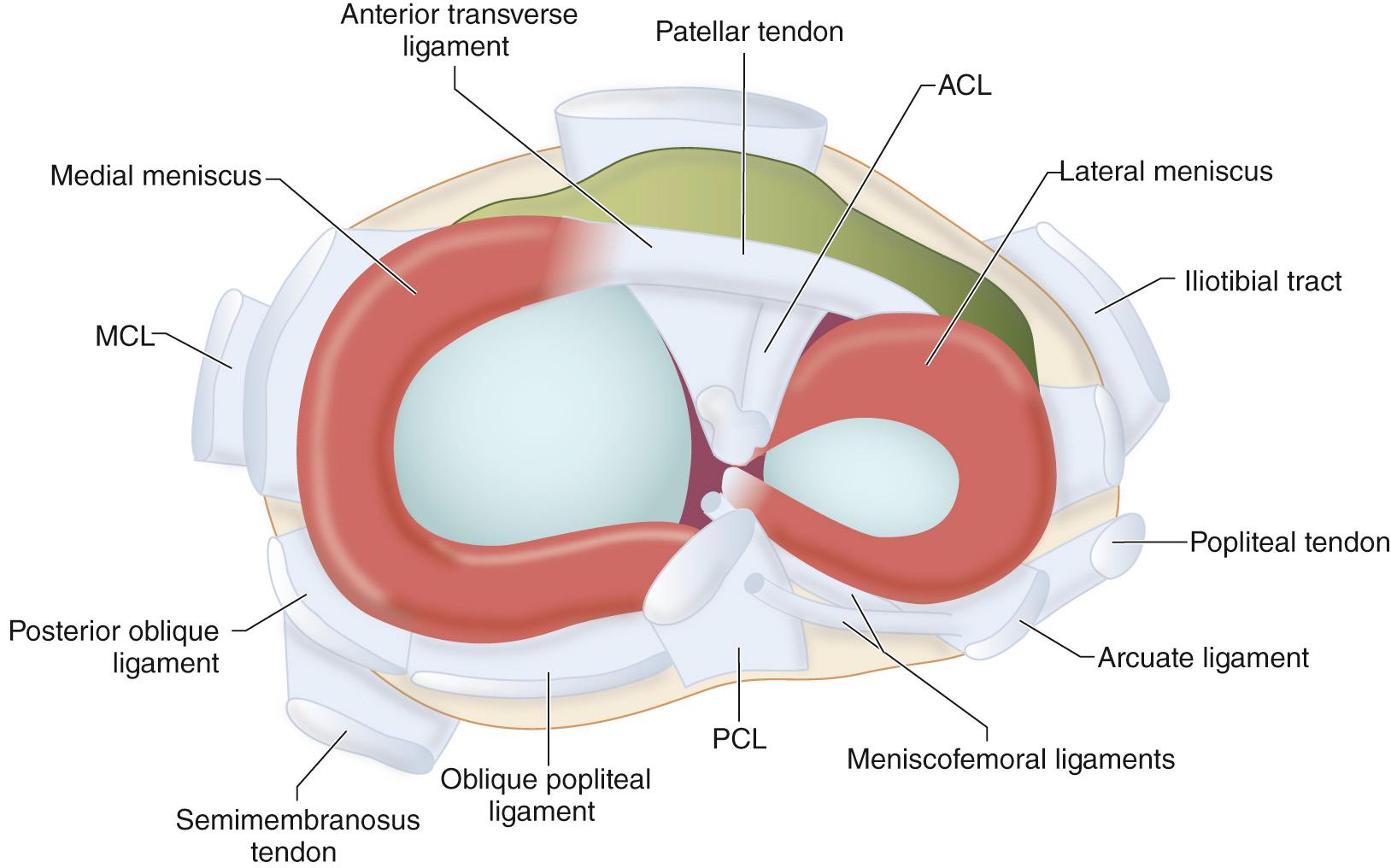
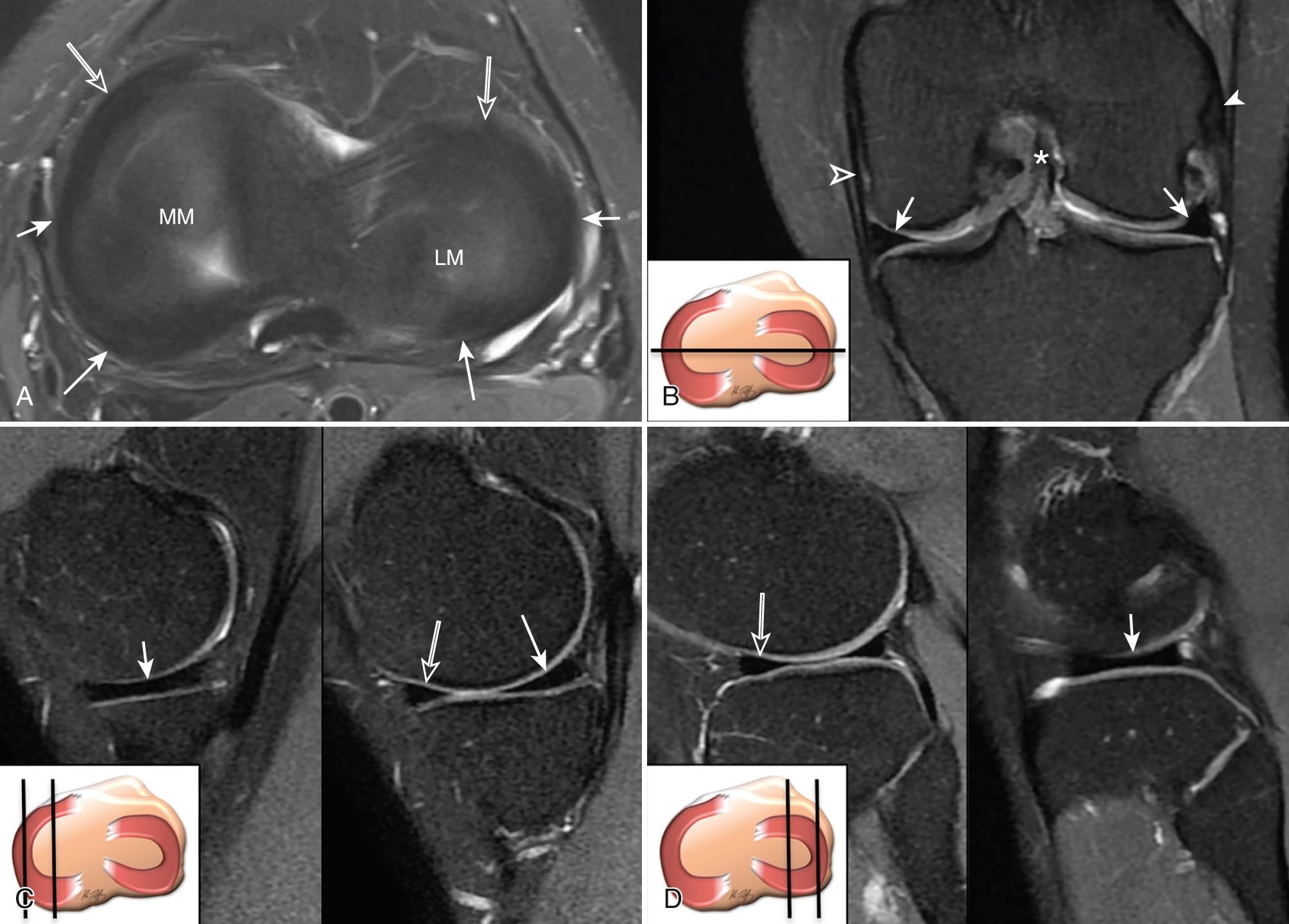
The anterior and posterior meniscal root ligaments are the strongest of the structures that attach the meniscus to the tibial plateau ( Fig. 7.3 ). Some similarities between meniscal roots and other ligamentous structures have been demonstrated on scanning electron microscopy and histology studies of meniscal attachments, leading to the term meniscal root ligaments . Other insertions of the medial and lateral menisci are the meniscotibial ligaments, which attach the meniscal body to the tibia, and a loose attachment of the meniscal body to the capsule.
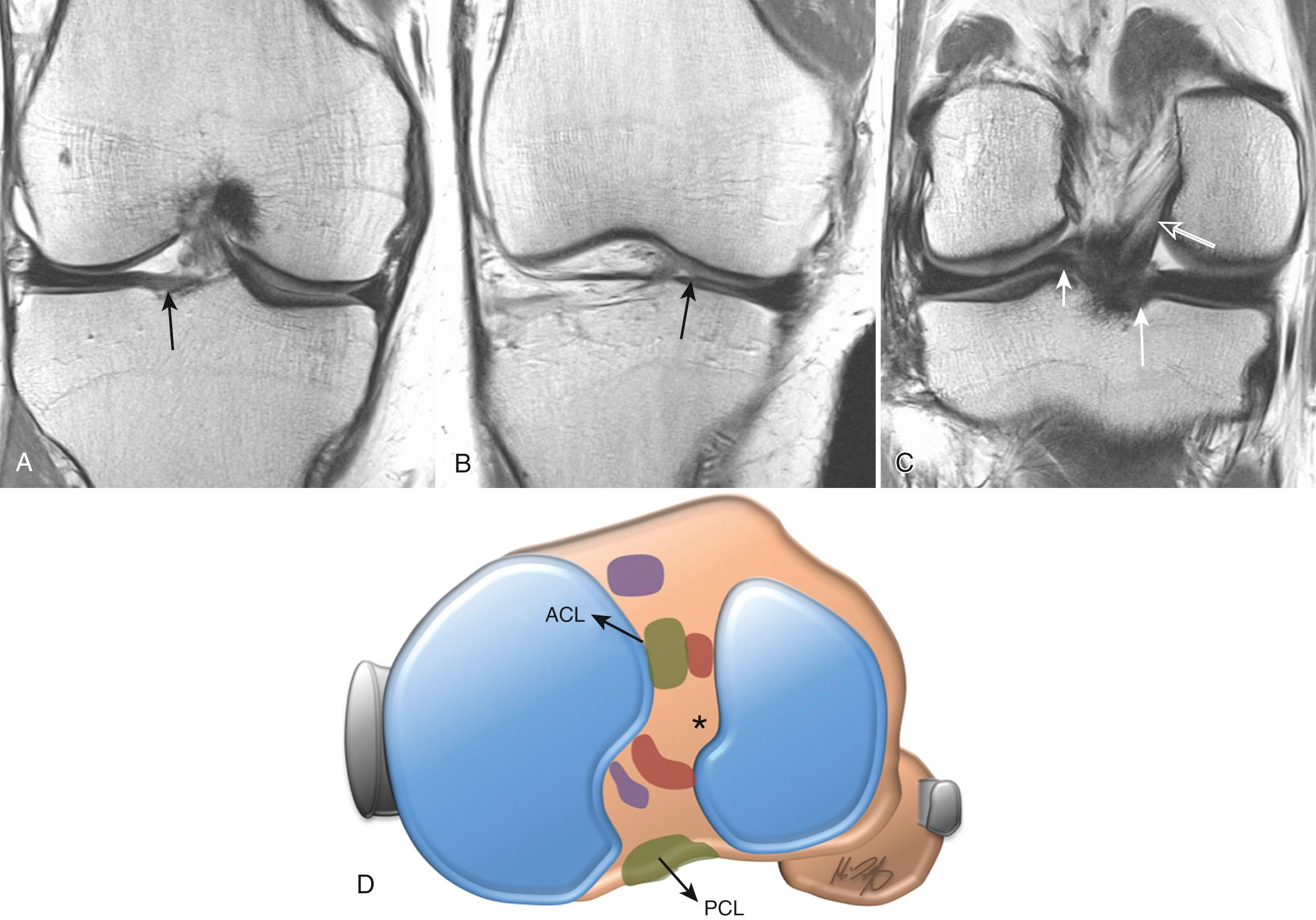
The medial meniscus has an open, C -shape configuration and is longer in its anteroposterior dimensions compared with the lateral meniscus in the axial plane. In cross-section the medial meniscus has a nonuniform, wedge-shape morphology with the posterior horn twice as large as the anterior horn. Although larger, the medial meniscus covers a smaller percentage of the articular surface of the tibia (50% to 60% compared with 70% for the lateral meniscus).
Medial meniscus root ligaments are located more superficially compared with lateral meniscus root ligaments because of the more open C -shape of the medial meniscus. Four insertion patterns of the anterior root ligament of the medial meniscus have been described: type I insertion, which is the most frequent, is located in the flat intercondylar region of the tibial plateau; type II insertion is more medial, close to articular tibial surface; type III insertion is more anterior, on the downward slope from the medial tibial plateau; type IV insertion shows no bony attachment. The attachment site of the posterior horn of the medial meniscus is located posterior to the medial tibial eminence and anteromedial to the posterior cruciate ligament (PCL) insertion (see Fig. 7.3 ).
The medial meniscus is entirely attached to the joint capsule, with the exception of a small area at the medial collateral ligament (MCL). The medial meniscus serves as origin of the meniscocapsular ligaments, meniscofemoral ligament, and meniscotibial or coronary ligament, which are structures that belong to the deep portion of the MCL. The meniscofemoral ligament originates from the outer superior margin of the meniscus to blend either with the superficial portion of the MCL or the femoral condyle 1 to 2 cm above the level of the joint space. The meniscotibial or coronary ligament is shorter compared with the meniscofemoral ligament and originates from the outer inferior margin of the meniscus to attach to the tibia, distal to the joint space. Fibrofatty tissue and the MCL bursa separate the medial meniscus and deep portion of the MCL from the superficial or main portion of the MCL ( Fig. 7.4 ). The meniscocapsular ligaments are not the only medial supporting structures closely related to the medial meniscus. The posterior portion of the MCL designated as the posterior oblique ligament fuses with the deep portion of the MCL and attaches closely to the posteromedial meniscus. Along the posterior aspect of the knee, the posterior oblique ligament envelops the posteromedial aspect of the medial femoral condyle where it takes the name of oblique popliteal ligament.
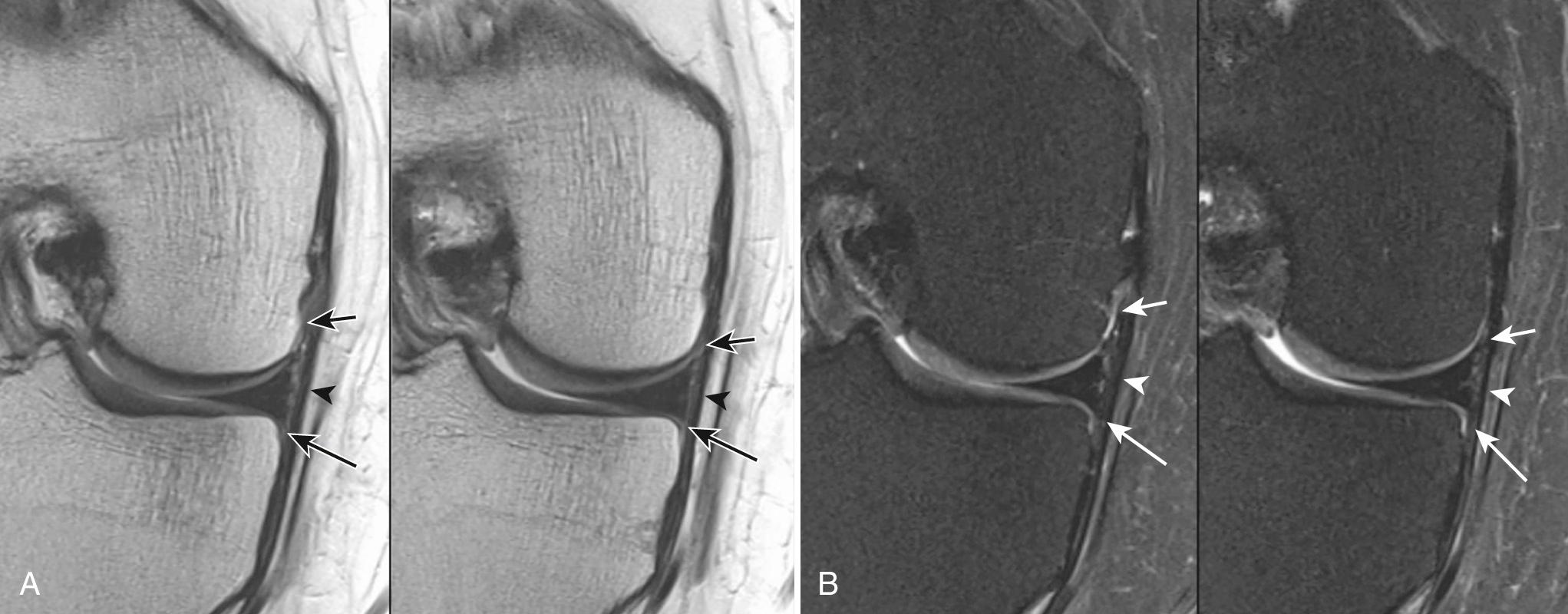
The lateral meniscus appears more rounded with a closed C -shape configuration in the axial plane. In cross-section the lateral meniscus has a uniform, wedge-shape morphology minimally and gradually enlarging from anterior to posterior.
The root ligament of the anterior horn of the lateral meniscus inserts immediately lateral to the origin of the anterior cruciate ligament (ACL). The posterior attachment of the lateral meniscus is located posteromedial to the lateral tibial eminence, anterior to the PCL insertion, and anterolateral to the medial meniscus posterior attachment (see Fig. 7.3 ).
The lateral meniscus is attached to the joint capsule only in the anterior and far posterior portions. A deep lamina of the capsule, part of the deep layer of the lateral supporting structures of the knee, travels deep to the lateral collateral ligament (LCL) and gives rise to the coronary ligament. In the lateral portion of the knee, the popliteal hiatus interrupts the meniscal capsular attachment at the body and portion of the posterior horn. The proximal intra-articular insertion of the popliteus tendon is situated within a shallow concavity in the lateral aspect of the femur, designated the popliteal sulcus. The tendon then takes a posteroinferior oblique course to the posterolateral corner of the knee. As it passes the posterior horn of the lateral meniscus, the popliteus tendon becomes extra-articular ( Fig. 7.5 ).
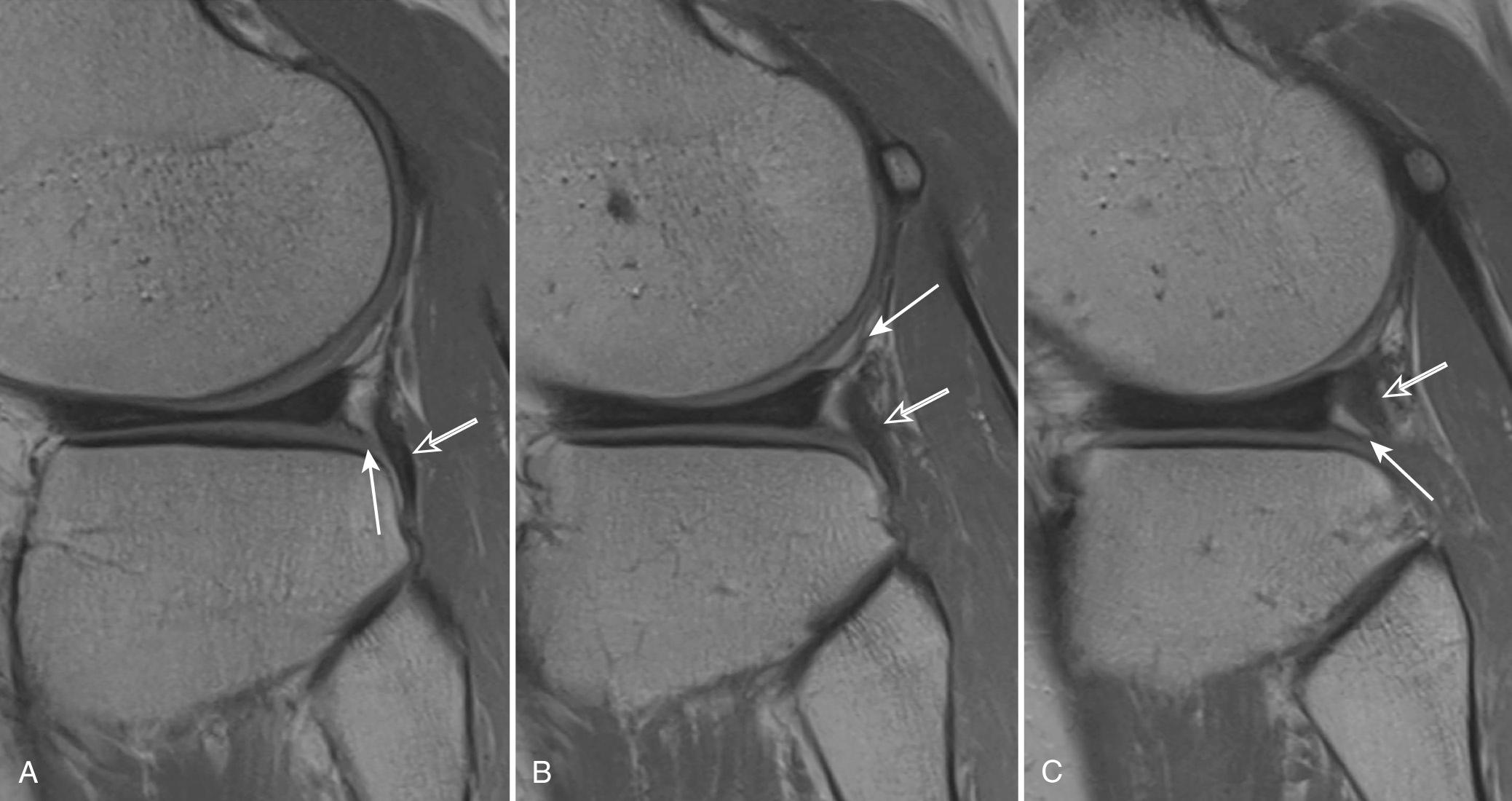
Knowledge of closely related structures to the meniscus is critical because they may simulate pathology and can also be injured. Some of these structures include the meniscofemoral ligaments, meniscomeniscal ligaments, ligamentum mucosum or infrapatellar plica, popliteomeniscal fascicles, and patellomeniscal ligament.
The meniscofemoral ligaments of Humphry and Wrisberg originate from the posterior horn of the lateral meniscus and insert onto the lateral aspect of the posterior medial femoral condyle, with the ligament of Humphry coursing anterior to the genu of the PCL and the ligament of Wrisberg coursing behind the genu of the PCL ( Figs. 7.6 and 7.7 ). The incidence of the meniscofemoral ligaments ranges from 50% to 76% in the literature. The ligament of Wrisberg is more frequently found than the ligament of Humphry, with a reported incidence of 90% and 17%, respectively, in a series of cadaveric specimens by Cho et al. Meniscofemoral ligament proximal insertion may vary, attaching only at the femoral condyle or attaching at the femoral condyle while some fibers blend with the PCL. In the latter type a hump in the PCL can be observed on sagittal MR images. The Wrisberg ligament is thicker than the Humphry ligament and is usually depicted with clarity on sagittal and coronal sections, whereas the Humphry ligament is better visualized on sagittal sections (see Figs. 7.6 and 7.7 ). In general, the attachment of the meniscofemoral ligaments to the posterior horn of the lateral meniscus should not extend greater than 14 mm beyond the lateral border of the PCL, otherwise a meniscal tear should be suspected.
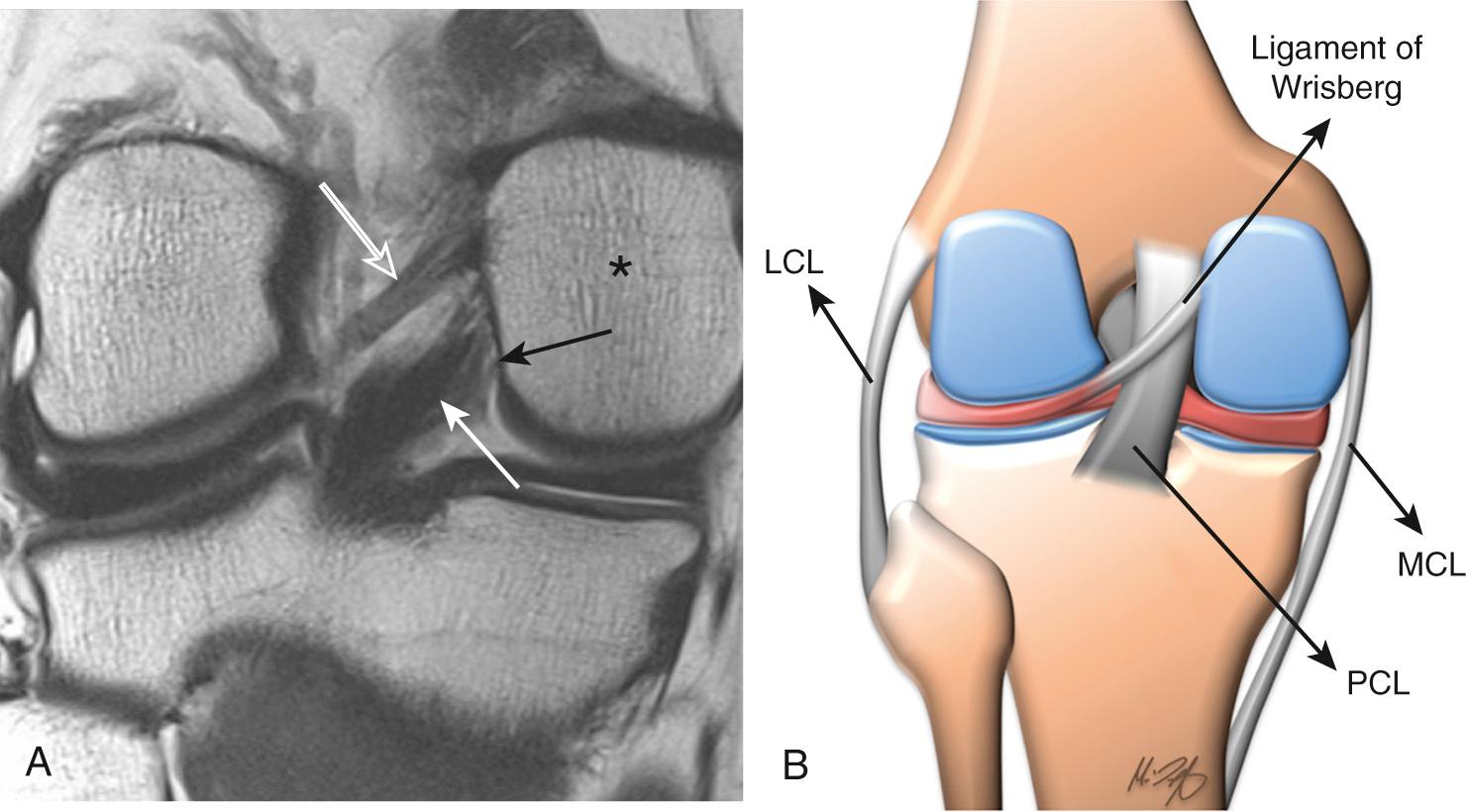
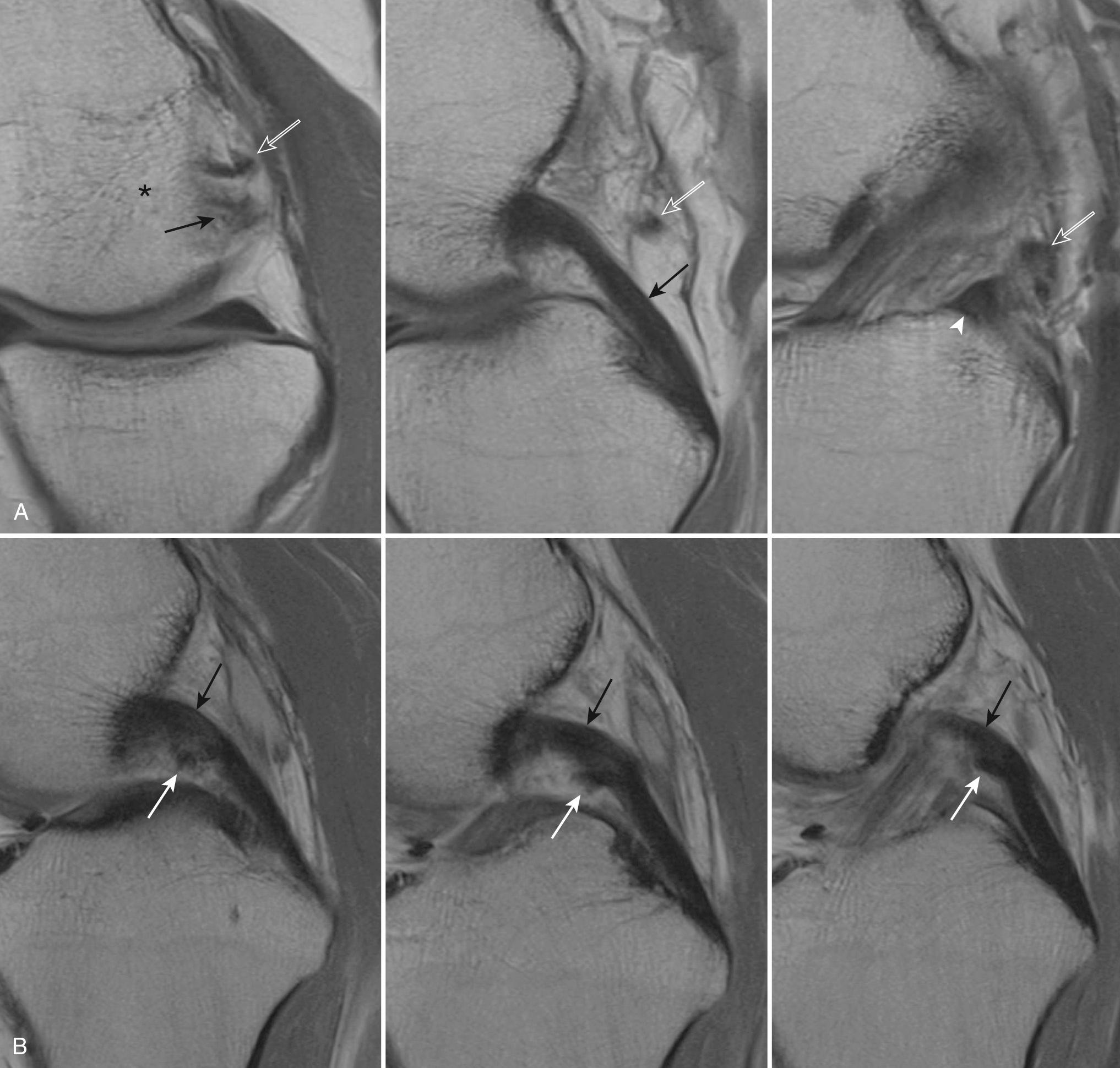
Literature describes four types of meniscomeniscal ligaments: the anterior transverse meniscal ligament, posterior transverse meniscal ligament, and medial and lateral oblique meniscomeniscal ligaments. The anterior transverse (geniculate) ligament of the knee is a structure frequently identified posterior to Hoffa fat pad, connecting the anterior convex margin of the lateral meniscus to the anterior horn of the medial meniscus ( Fig. 7.8 ). This ligament is present in 50% to 90% of gross specimens and has an important function in restricting anteroposterior excursion of the anterior horn of the medial meniscus during the early phase of knee flexion. The anterior transverse ligament of the knee is closely related to the ligamentum mucosum or infrapatellar plica, a structure that extends from Hoffa fat pad to the apex of the intercondylar notch of the femur ( Fig. 7.9 ). In some cases the ligamentum mucosum may have an attachment to the inferior pole of the patella. A synovial cleft may be found beneath the ligamentum mucosum in the posteroinferior portion of Hoffa fat pad in 11% to 14% of individuals. The posterior transverse meniscal ligament has a reported prevalence of 1% to 4% and connects the posterior horns of the medial and lateral menisci. The medial and lateral oblique meniscomeniscal ligaments are intrameniscal ligaments that run obliquely from the anterior horn of one of the meniscus to the posterior horn of the opposite meniscus. Their combined prevalence in the literature ranges from 1% to 4%. Each oblique meniscomeniscal ligament receives its name from its anterior meniscal origin and passes between the anterior and PCLs as it traverses the intercondylar notch. In addition to the classical four intermeniscal ligament variants, two new structures have been reported: unilateral medial and lateral intermeniscal ligaments.
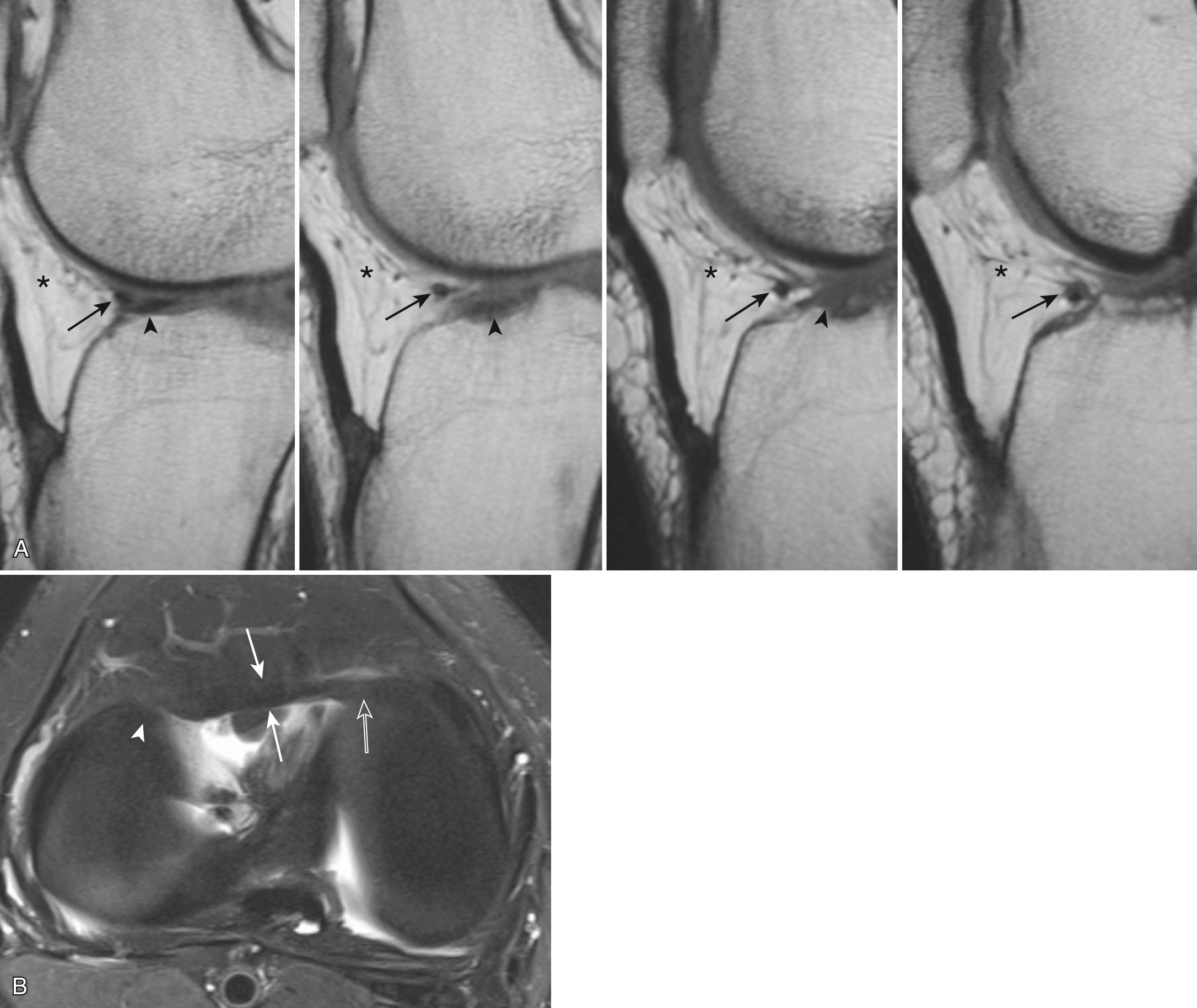
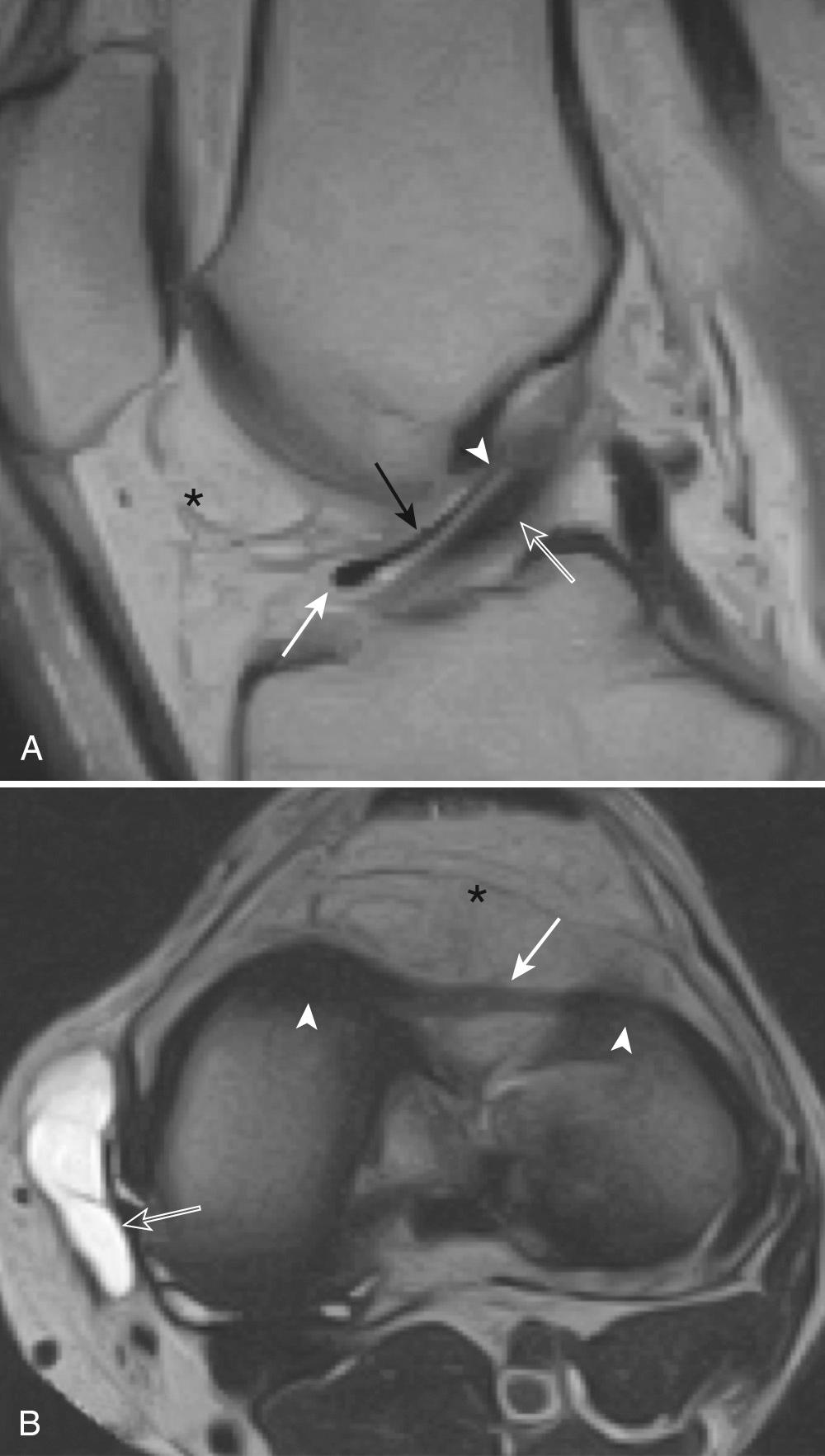
The popliteomeniscal fascicles attach the popliteus tendon to the lateral meniscus and are considered important meniscal stabilizers (see Fig. 7.5 ). Two fascicles have been commonly recognized: anteroinferior and posterosuperior fascicles. The anteroinferior popliteomeniscal fascicle extends from the lateral edge of the body of the meniscus to the inferior portion of popliteal paratenon and forms the floor of the popliteal hiatus. The lateral portion of the fascicle fuses with the popliteofibular ligament to form a conjoined attachment at the fibular styloid process. The posterosuperior popliteomeniscal fascicle extends from the body and portion of the posterior horn of the lateral meniscus to the superior portion of the popliteal paratenon and the capsule and forms the roof of the popliteal hiatus. This fascicle has a posterior course and attaches to the posterior capsule. Some authors have described a third popliteomeniscal fascicle, known as the posteroinferior popliteomeniscal fascicle. The posteroinferior popliteomeniscal fascicle is located medial to the popliteal hiatus extending from the inferior margin of the posterior horn of the lateral meniscus near the posterior meniscofemoral ligament of Wrisberg to the medial aponeurosis of the popliteus muscle.
The patellomeniscal ligament, part of the middle layer of the lateral supporting structures of the knee, travels from the patella to the lateral meniscus deep to the iliotibial tract.
The meniscal blood supply is derived from the medial and lateral geniculate arteries. In adults the peripheral 20% to 30% of the meniscus is vascularized (red zone), whereas the inner two-thirds are relative avascular (white zone). A mixed-vascularity pink zone is described at the red-white junction. The extent of meniscal vascularization is similar in both lateral and medial menisci and appears to be more pronounced at the anterior and posterior horn than in the body. The vascular and avascular zones can be differentiated histologically but not with direct inspection.
Meniscal tissue is mainly composed of water (72% water), with the remaining composed of organic matter, mostly extracellular matrix and cells. A collagen network is the main component of the organic matter (75%), and different collagen types exist in varying quantities in each region of the meniscus. Collagen type I predominates in the red zone of the meniscus, and collagen types I and II are present in the white zone of the meniscus. Collagen fibers are arranged in three distinct layers in the meniscus cross section: (1) superficial network, a meshwork of thin fibers at tibial and femoral meniscus surfaces; (2) lamellar layer, beneath the superficial network; and (3) central main layer, which has the circular bundles of collagen fibers oriented parallel to the longitudinal axis of the meniscus and the radial fibers, traveling perpendicular to the long axis of the meniscus ( Fig. 7.10A ). Although the principal orientation of the collagen fibers is circumferential, the radial fibers appear on both femoral and tibial meniscal surfaces and within the substance of the menisci. The longitudinally oriented fibers predominate at the meniscal periphery and that could explain why longitudinal tears occur more frequently at the periphery of the meniscus. The “middle perforating” or “tie” fibers are condensed, radially oriented fibers located in the substance of meniscal tissue, which could explain the frequent location of radial tears in this location. Knowledge of the collagen architecture of the meniscus is important to understand the different types of meniscal tears and the appropriate use of meniscal repair techniques.
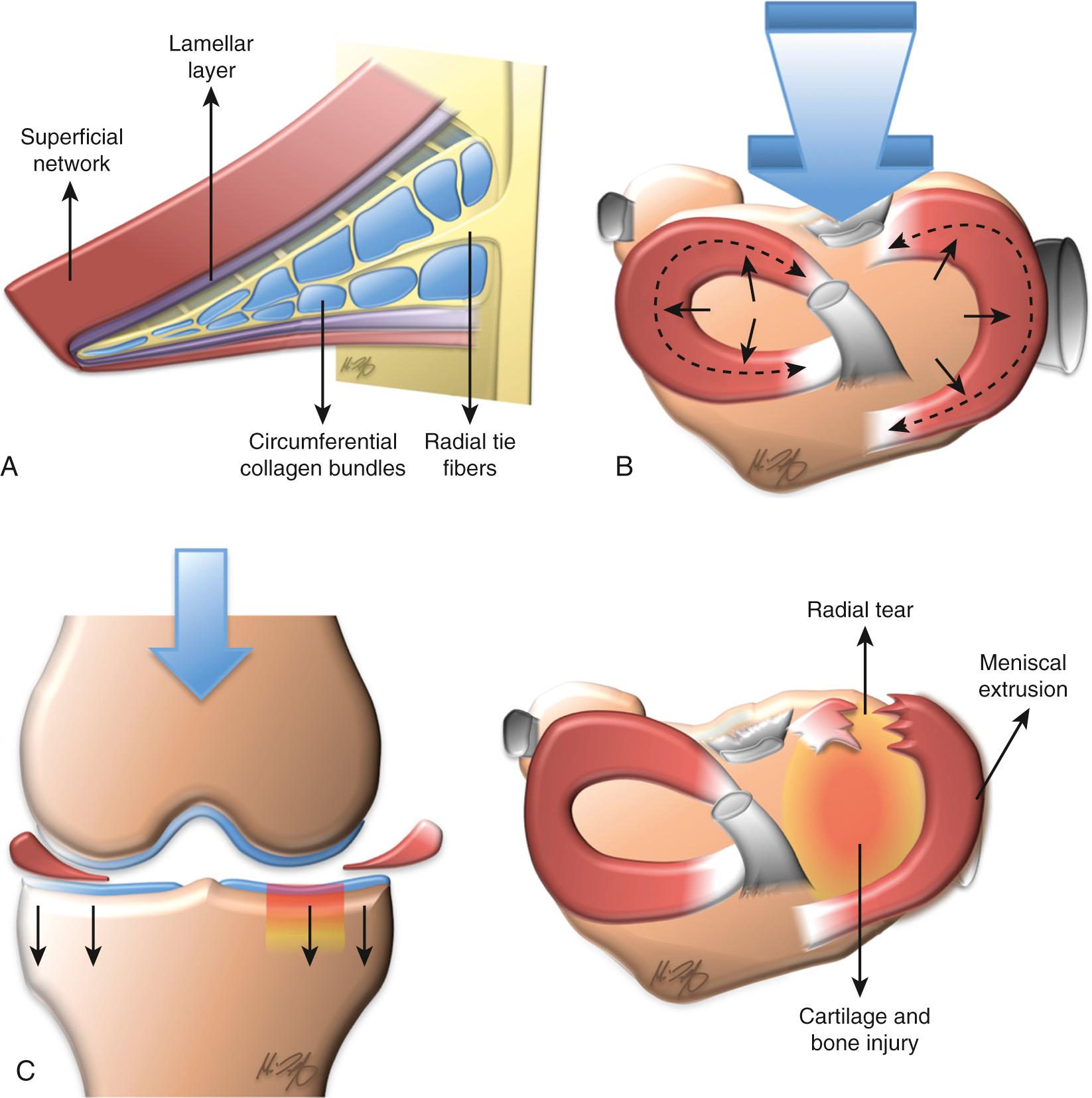
In histologic studies the root ligaments demonstrate the typical structure of an enthesis at the attachment to the tibia, transitioning from the meniscal substance to uncalcified fibrocartilage, calcified cartilage, and ultimately bone. The midsubstance of the root ligaments has a microstructure very similar to that of other ligaments. It is composed of parallel collagen bundles and a connective tissue sheath embracing them. Attachment of the anterior and posterior horns of the menisci via root ligaments have been characterized in cadavers and by MRI because proper selection of the anchoring sites at surgery is critical to restore normal meniscal function.
The menisci perform several important functions in the knee joint: (1) increase stabilization of the knee by deepening the contact between femoral condyles and tibial plateau; (2) distribute axial loads and absorb shock by distributing hoop forces evenly across the articulating surfaces; (3) assist in joint lubrication and facilitate nutrient distribution; and (4) aid in proprioception because of the nerve fibers located in the anterior and posterior thirds.
During knee flexion, the medial meniscus moves an average of 2 to 5 mm, whereas the lateral meniscus is more mobile, with an anteroposterior displacement of approximately 9 to 11 mm along the tibial articular surface. The lateral meniscus moves as a single unit, whereas the medial meniscus anterior horn is more mobile than its posterior horn. The posteromedial portion of the medial meniscus is the least mobile region of the meniscus because of the constraint of the adjacent posterior oblique ligament. Changes in meniscal morphology during flexion and extension allow meniscal surface to maintain contact with the femur and tibia throughout movement.
The arrangement of meniscal collagen fibers is ideal for transferring a vertical compressive load into circumferential “hoop” stresses. Collagen fibers are oriented circumferentially in the deeper layers of the meniscus, parallel to the peripheral border. These fibers blend the ligamentous connections of the meniscal horns to the tibial articular surface. Hoop stresses are generated as axial forces and converted to tensile stresses along the circumferential collagen fibers of the meniscus (see Fig. 7.10B ). The wedge shape of the meniscus gives it a tendency to extrude from between the femoral and tibial condyles and firm attachments via root ligaments prevent the meniscus from extruding peripherally during load bearing. Studies have demonstrated that 70% of the load in the lateral compartment and 50% of the load in the medial compartment is transmitted through the menisci. The thinner radial tie fibers are interposed perpendicular to the circumferential fibers and act to tie bundles together, preventing the circumferential fibers to split apart when hoop stress is applied to the meniscus.
Radial tears extending to the periphery disrupt the collagen fibers and may reduce meniscal hoop strength, severely impairing meniscal function (see Fig. 7.10C ). In contrast, only compressive loads are observed across longitudinal tears with maximum loads at full knee extension or at 90-degree knee flexion.
Injuries that involve root ligaments severely affect meniscal biomechanics and kinematics, leading to accelerated degenerative changes within the knee joint. Injuries to the posterior meniscus root ligaments, including root avulsion, full-length tears, and radial tears of the posterior horn adjacent to the root, have been associated with significant meniscal extrusion. Meniscal extrusion may impair hoop stress force transmission, increasing peak tibiofemoral contact pressures similar to that of meniscectomy.
In 1948 Fairbank described an increased incidence and predictable degenerative changes of the articular surfaces in completely menisectomized knees. After Fairbank's report, numerous studies have confirmed these findings. After total meniscectomy the contact areas decrease by 50% to 75% and the contact pressure increases two to three times. The increased load may contribute to cartilage injury and degeneration. Misalignment, concurrent articular pathology, and ligament instability have been associated with an accelerated development of OA in menisectomized knees. A higher prevalence of late OA has been found in partially menisectomized knees compared with normal knees, with radiographic signs of OA four to seven times more frequent in the partially menisectomized knees. Individuals with partial meniscectomy have better functional outcome than those with total meniscectomy. The amount of meniscal tissue excised has been shown to be inversely related to the proper function of the meniscus. Specifically those individuals with large resection of the posterior horn will have the worst functionality. Demonstration of biomechanical alterations and higher risk of OA after partial or total meniscectomy has led to surgical techniques in which the goal is to maintain the tissue intact whenever possible.
MRI has evolved into the preferred noninvasive imaging modality for evaluating internal knee derangement since its first use in the clinical setting. During the past two decades MRI has been the modality of choice in the imaging diagnosis of meniscal tears. MRI has demonstrated high sensitivity and specificity for detection of meniscal tears, with arthroscopy as the reference standard.
Menisci are hypointense on T1- and T2-weighted MR images, with intermediate to long time to echo (TE) because of their fibrocartilaginous composition. The MR properties of meniscal tissue relate to the extremely rapid T2 relaxation resulting from the high intrameniscal content of collagen and other short T2 components. Higher signal intensity may be demonstrated in the peripheral third of the meniscus in young individuals, representing normal vascularity or tie fibers.
The MR appearance of the meniscus depends on the orientation of the imaging plane with respect to the axis of the meniscus (see Fig. 7.2 ). On axial MR images menisci have a semilunar or C -shape configuration, and the differences between lateral meniscus with a closed C -shape and medial meniscus with a more open C -shape can be demonstrated. When imaged perpendicular to the meniscal longitudinal axis, menisci have a triangular or wedge appearance. Therefore the anterior and posterior horns are seen as triangular or wedged structures on sagittal MR images, whereas the meniscal body is seen as a triangular or wedged shape on coronal MR images. The apex of the triangle points to the intercondylar notch, the base is oriented peripherally, the superior surface of the triangle is slightly concave and accommodates the femoral condyle, and the inferior surface is flat and lies on the tibial plateau. Menisci take on a more slab or bow tie configuration when the imaging plane is oriented parallel to the long axis of the meniscus (ie, anterior and posterior horns on coronal MR images and meniscal body on coronal MR images). Differences in size between the anterior and posterior horns of the meniscus can be appreciated on sagittal sections in which anterior and posterior horns of the lateral meniscus are similar, whereas the posterior horn of the medial meniscus can be twice as large as the anterior horn.
Several sequences have been advocated for imaging of meniscal tears. MR images with short TEs and high-resolution MR images are required to improve detection of meniscal tears.
Although protocols may vary, most meniscal tears are best demonstrated on the sagittal plane. It has been shown that up to 97% of medial and 96% of lateral meniscal tears can be identified on sagittal MR images. Proton density (PD) sequences which use long time to repetition (TR) and short TEs are optimal in the detection of the increased signal intensity seen in meniscal tears. Most recent articles support the use of either conventional spin echo (SE) PD sequences or fast spin echo (FSE) PD sequences to detect meniscal tears. Rubin et al. found similar sensitivities and specificities when comparing FSE and SE PD sequences with arthroscopy as the reference standard. The major advantage of FSE is faster imaging times with decreasing motion artifacts but with an increase in image blurring. The use of lower echo train lengths (four or less), high-performance extremity gradient coils, and longer bandwidths (in the 30s or higher) allows a decrease in image blurring.
Spatial resolution can be improved by maximizing the matrix size while maintaining a small field of view (FOV) and thin section thickness. These parameters will result in a decrease in the signal-to-noise ratio (SNR), which can be partially compensated for by increasing the number of excitations (NEX of 2) and using dedicated high-performance extremity gradient coils. Typical parameters for meniscal imaging include an FOV of 16 cm or less, a matrix size of at least 192 (phase-encoding direction) × 256 (frequency-encoding direction), and slice thickness of 3 to 4 mm.
Three tesla (3 T) MRI allows for a higher SNR compared with 1.5-T imaging. This can be used to improve imaging acquisition speed or resolution. However, there is increased sensitivity to magnetic susceptibility artifacts and chemical shift artifacts compared with 1.5 T. Despite the advantages in SNR, speed, and resolution with the 3-T MRI, studies have found comparable accuracies between 1.5- and 3-T imaging.
Meniscal tears are among the most common knee injuries. The prevalence of meniscal tears increase with age, and meniscal tears are often associated with and contribute to degenerative joint disease. Tears are more common in the posterior horn of the menisci, especially in the medial meniscus, because of its decreased mobility compared with the lateral meniscus.
Meniscal tears can be traumatic or degenerative. Traumatic tears result when an excessive force is applied to a normal meniscus during trauma, exceeding the capacity of the meniscal tissue to deform. Radial and vertical tears are most frequently created with this mechanism of injury, although horizontal or oblique tears may also occur. Degenerative tears on the other side occur from normal forces acting on degenerated tissue and are mostly horizontal cleavage tears.
MRI has proved to be highly accurate in detection of meniscal injuries, with excellent arthroscopic correlation. A meta-analysis of published articles between 1991 and 2000 reported a pooled sensitivity and specificity of 93% and 88%, respectively, for medial meniscal tears and 79% and 96%, respectively, for lateral meniscal tears. Several factors, such as sample size, technical parameters, and accuracy of arthroscopic findings, the current reference standard, accounted for differences in accuracy. Reported sensitivity and specificity of conventional SE and FSE MRI at 1.5 T for diagnosing meniscal tears compared with arthroscopy ranges from 86% to 97% and 84% to 94%, respectively, for medial meniscus and from 70% to 92% and 89% to 98%, respectively, for lateral meniscus.
The diagnosis of meniscal tears has been based on two main criteria: linear intrameniscal signal intensity extending into the superior and/or inferior surfaces and morphologic alterations of the meniscus in the absence of prior surgery. To assist with correct classification of a tear, meniscal signal has been categorized into different grades: grade 0 consists of a normal, uniform, low-signal intensity; grade 1 consists of an intrameniscal globular or ovoid high signal that is not communicating with an articular surface; grade 2 consists of an intrameniscal linear or wedge-shape signal that is not communicating with an articular surface; grade 3a is an intrameniscal signal that equivocally contacts the articular surface; and grade 3b is an intrameniscal signal that clearly contacts the articular surface. Only grade 3 signal represents a tear. Grade 1 or 2 signal does not indicate a tear and is associated with normal vascularity in children and tissue degeneration in adults. There is a high probability for a meniscus to be torn when abnormalities in signal intensity or morphology are seen in two or more MR images and considerably less likely to be torn when abnormalities are seen in only one MR image. De Smet et al. have presented these findings as the “two-slice-touch” rule and have found an increase in positive predictive values (PPVs) compared with the standard diagnostic criteria using one or more MR images. In their study the PPV increased from 91% to 94% for medial meniscal tears and from 83% to 96% for lateral meniscal tears.
Despite the high accuracy of MRI for diagnosing tears, false-positive diagnoses still occur and are more common in the medial meniscus than in the lateral meniscus. False-positive diagnoses are frequently associated with longitudinal, root ligament and radial tears compared with bucket-handle, complex, flap, and horizontal tears, with complex tears having the lowest frequency of false-positive diagnosis. Of all the meniscal tear types, longitudinal tears have the lowest reported PPV, especially those located at the meniscocapsular junction. Spontaneous meniscal healing may contribute to a false-positive diagnosis, particularly in those cases in which arthroscopy is performed 6 weeks after the MR examination. The sensitivity of MRI for diagnosing meniscal tears has been consistently lower for lateral meniscal tears compared with medial meniscal tears and may vary with tear location, extension, and type. It has been shown that tears that involve one-third or less of the meniscus, tears located at the posterior horn, or longitudinal type tears are the most frequently missed meniscal tears in the lateral meniscus.
Become a Clinical Tree membership for Full access and enjoy Unlimited articles
If you are a member. Log in here